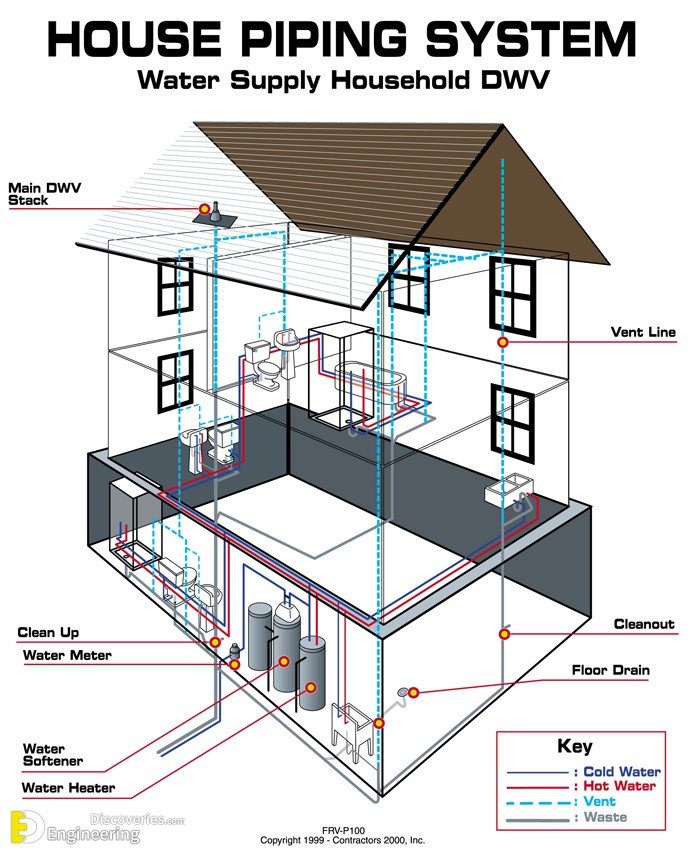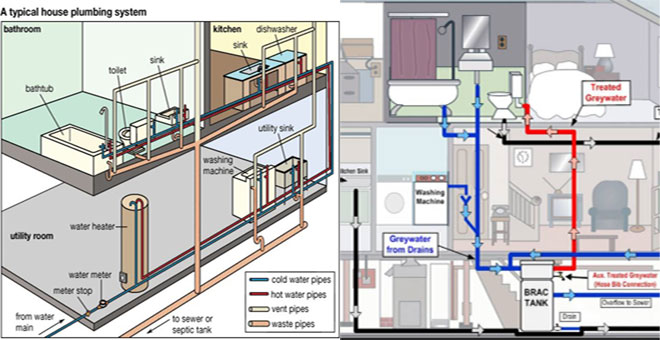Are you currently trying to locate resources about Exploring Your Homes Plumbing Anatomy?

Recognizing how your home's plumbing system works is necessary for every single house owner. From supplying tidy water for alcohol consumption, cooking, and showering to safely eliminating wastewater, a well-kept pipes system is essential for your household's health and wellness and comfort. In this extensive guide, we'll discover the intricate network that composes your home's pipes and deal pointers on upkeep, upgrades, and dealing with common issues.
Introduction
Your home's plumbing system is greater than simply a network of pipelines; it's an intricate system that guarantees you have access to clean water and reliable wastewater elimination. Understanding its components and exactly how they work together can aid you avoid costly repairs and ensure every little thing runs smoothly.
Basic Components of a Pipes System
Pipelines and Tubes
At the heart of your pipes system are the pipes and tubing that carry water throughout your home. These can be constructed from numerous products such as copper, PVC, or PEX, each with its advantages in terms of sturdiness and cost-effectiveness.
Fixtures: Sinks, Toilets, Showers, etc.
Components like sinks, commodes, showers, and tubs are where water is utilized in your home. Understanding exactly how these fixtures attach to the plumbing system aids in identifying problems and preparing upgrades.
Valves and Shut-off Factors
Valves regulate the flow of water in your pipes system. Shut-off valves are crucial throughout emergencies or when you require to make repairs, permitting you to isolate parts of the system without interfering with water circulation to the entire residence.
Supply Of Water System
Key Water Line
The primary water line attaches your home to the community water supply or a personal well. It's where water enters your home and is dispersed to different components.
Water Meter and Pressure Regulatory Authority
The water meter measures your water use, while a stress regulator guarantees that water moves at a secure pressure throughout your home's plumbing system, stopping damage to pipelines and fixtures.
Cold Water vs. Warm water Lines
Comprehending the difference between cold water lines, which provide water directly from the major, and hot water lines, which lug heated water from the hot water heater, helps in repairing and planning for upgrades.
Water drainage System
Drain Water Lines and Traps
Drain pipelines lug wastewater far from sinks, showers, and toilets to the sewer or septic tank. Traps stop drain gases from entering your home and likewise trap debris that might trigger obstructions.
Air flow Pipelines
Air flow pipelines permit air right into the drain system, stopping suction that might slow down drain and trigger catches to empty. Proper ventilation is necessary for maintaining the stability of your pipes system.
Significance of Correct Drainage
Making sure correct drainage stops backups and water damage. Consistently cleansing drains and preserving catches can prevent expensive fixings and extend the life of your plumbing system.
Water Furnace
Types of Water Heaters
Water heaters can be tankless or standard tank-style. Tankless heating systems heat water on demand, while containers keep warmed water for immediate usage.
Exactly How Water Heaters Connect to the Plumbing System
Recognizing just how water heaters attach to both the cold water supply and hot water distribution lines assists in detecting issues like not enough warm water or leaks.
Maintenance Tips for Water Heaters
Consistently purging your water heater to eliminate debris, examining the temperature level setups, and inspecting for leakages can expand its lifespan and boost power efficiency.
Common Plumbing Issues
Leaks and Their Causes
Leakages can happen because of aging pipes, loose installations, or high water stress. Resolving leakages promptly prevents water damages and mold and mildew growth.
Clogs and Blockages
Clogs in drains and toilets are typically triggered by purging non-flushable things or a buildup of oil and hair. Using drain screens and being mindful of what decreases your drains can prevent obstructions.
Indicators of Pipes Troubles to Watch For
Low tide pressure, sluggish drains, foul odors, or unusually high water expenses are signs of potential plumbing issues that should be dealt with quickly.
Plumbing Upkeep Tips
Regular Evaluations and Checks
Arrange annual plumbing inspections to capture concerns early. Seek indicators of leakages, deterioration, or mineral buildup in faucets and showerheads.
DIY Upkeep Tasks
Basic jobs like cleansing tap aerators, looking for bathroom leakages utilizing dye tablets, or insulating exposed pipelines in cool environments can stop major pipes concerns.
When to Call a Specialist Plumber
Know when a pipes concern calls for expert experience. Trying intricate repair work without correct expertise can result in more damage and greater fixing costs.
Updating Your Pipes System
Reasons for Upgrading
Updating to water-efficient components or changing old pipes can improve water quality, reduce water costs, and raise the worth of your home.
Modern Plumbing Technologies and Their Benefits
Discover modern technologies like wise leakage detectors, water-saving toilets, and energy-efficient hot water heater that can conserve money and reduce ecological effect.
Expense Considerations and ROI
Determine the upfront prices versus long-lasting savings when taking into consideration plumbing upgrades. Several upgrades pay for themselves with reduced utility bills and fewer repairs.
Ecological Effect and Conservation
Water-Saving Components and Home Appliances
Mounting low-flow faucets, showerheads, and commodes can considerably lower water usage without compromising performance.
Tips for Minimizing Water Usage
Basic routines like dealing with leaks quickly, taking much shorter showers, and running complete loads of washing and meals can preserve water and reduced your utility expenses.
Eco-Friendly Pipes Options
Consider sustainable pipes materials like bamboo for flooring, which is durable and environmentally friendly, or recycled glass for counter tops.
Emergency situation Preparedness
Steps to Take Throughout a Pipes Emergency situation
Know where your shut-off valves lie and just how to turn off the supply of water in case of a ruptured pipeline or major leak.
Value of Having Emergency Situation Contacts Handy
Keep get in touch with details for neighborhood plumbings or emergency services easily available for quick reaction during a plumbing dilemma.
Do It Yourself Emergency Situation Fixes (When Relevant).
Temporary solutions like utilizing air duct tape to spot a leaking pipe or placing a container under a leaking tap can decrease damages until a professional plumbing shows up.
Final thought.
Recognizing the makeup of your home's pipes system equips you to maintain it effectively, conserving money and time on repair services. By following regular upkeep regimens and remaining informed concerning modern-day plumbing technologies, you can ensure your pipes system runs effectively for years ahead.
HOW YOUR PLUMBING SYSTEM WORKS
Which Pipes Do What?
Blue lines = fresh water supply entering the building
Red lines = hot water supply entering the building
Grey lines = pipes carrying waste away from the building and venting pipes carrying gases away from the building (through the roof)
YOUR MAIN PLUMBING SYSTEMS
There are two main plumbing systems that support your home s basic plumbing needs one that brings clean water into your home, and one that sends dirty water away from your home. Connected to the toilet, bath, shower, and other faucets in your home, these two systems keep your water flowing in the right directions.
ACCESSING FRESH WATER
Fresh and clean water is brought into your home through the main water supply line . Filtered through one pipe, this water is pressured to flow into the various fixtures in your home at any given time.
This water can be sourced from a well located on your property, a pond or river (mostly cottages), or, as in most cases, from the city s municipal water treatment centre. However, it is important to note that water that is untreated, such as the water siphoned from ponds or rivers, may not be safe to drink. Personal water supplies always need to be treated for hardness and contaminants before consumed.
MUNICIPAL WATER SUPPLIES
Improve taste and odour
Remove sediment
Eliminate hardness
Reduce chlorine
COLD WATER SUPPLY VS. HOT WATER SUPPLY
Cold water flows into your home or building through the service line, which then distributes hot or cold water to your fixtures. This line is most commonly run through a central column that runs floor to floor. Hot water runs in short and straight pipes as the longer the pipeline, the more heat that will be lost in the transfer. Having shorter pipes also allows residents to access hot water more quickly.
WASTE WATER SYSTEM
Your wastewater system is divided into two parts pipes that send wastewater away from your home and venting pipes that send sewer gas away from your home. Sewage water travels through pipes that flush the water and waste towards local sewers that are operated and managed by your city or town. Most sewer systems rely on gravity to move the wastewater to where it needs to go.
The further away from your toilet or sink, the larger wastewater pipes become. This allows for waste to be disposed of from various parts of your home or business at once without pipe blockages. The angle and flow of these pipes are also essential for keeping your waste pipes clear of build up.
https://harrisplumbing.ca/how-your-home-plumbing-system-works/

HOW YOUR PLUMBING SYSTEM WORKS
Which Pipes Do What?
YOUR MAIN PLUMBING SYSTEMS
There are two main plumbing systems that support your home s basic plumbing needs one that brings clean water into your home, and one that sends dirty water away from your home. Connected to the toilet, bath, shower, and other faucets in your home, these two systems keep your water flowing in the right directions.
ACCESSING FRESH WATER
Fresh and clean water is brought into your home through the main water supply line . Filtered through one pipe, this water is pressured to flow into the various fixtures in your home at any given time.
This water can be sourced from a well located on your property, a pond or river (mostly cottages), or, as in most cases, from the city s municipal water treatment centre. However, it is important to note that water that is untreated, such as the water siphoned from ponds or rivers, may not be safe to drink. Personal water supplies always need to be treated for hardness and contaminants before consumed.
MUNICIPAL WATER SUPPLIES
COLD WATER SUPPLY VS. HOT WATER SUPPLY
Cold water flows into your home or building through the service line, which then distributes hot or cold water to your fixtures. This line is most commonly run through a central column that runs floor to floor. Hot water runs in short and straight pipes as the longer the pipeline, the more heat that will be lost in the transfer. Having shorter pipes also allows residents to access hot water more quickly.
WASTE WATER SYSTEM
Your wastewater system is divided into two parts pipes that send wastewater away from your home and venting pipes that send sewer gas away from your home. Sewage water travels through pipes that flush the water and waste towards local sewers that are operated and managed by your city or town. Most sewer systems rely on gravity to move the wastewater to where it needs to go.
The further away from your toilet or sink, the larger wastewater pipes become. This allows for waste to be disposed of from various parts of your home or business at once without pipe blockages. The angle and flow of these pipes are also essential for keeping your waste pipes clear of build up.
https://harrisplumbing.ca/how-your-home-plumbing-system-works/
I recently found that write up on The Inner Workings of Your Home's Plumbing while doing a lookup on the search engines. Liked our write-up? Please share it. Help somebody else discover it. Thanks for taking the time to read it.
About This